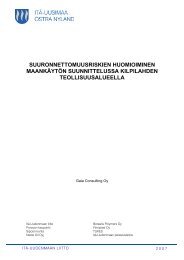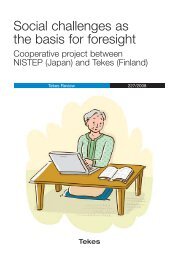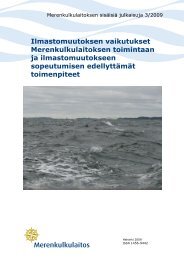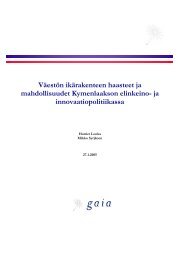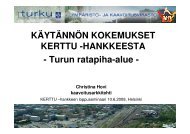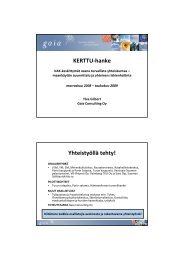Climate Risk Management in Finnish Development Cooperation - Gaia
Climate Risk Management in Finnish Development Cooperation - Gaia
Climate Risk Management in Finnish Development Cooperation - Gaia
Create successful ePaper yourself
Turn your PDF publications into a flip-book with our unique Google optimized e-Paper software.
notes that warm<strong>in</strong>g <strong>in</strong> Africa is very likely to be larger than the global annual mean warm<strong>in</strong>g<br />
throughout the cont<strong>in</strong>ent and <strong>in</strong> all seasons, with drier subtropical regions warm<strong>in</strong>g more<br />
than the moister tropics.<br />
In recent scenario work conducted for Ethiopia for the period 2040-2069 temperatures are<br />
projected to <strong>in</strong>crease between 1°C and 3°C. For the period 2070-2099 the scenarios and<br />
models suggest temperatures <strong>in</strong>creases of 2°C to 4°C, with the possibility that the <strong>in</strong>crease<br />
may be as high as 6°C (see figure 7).<br />
Figure 7. Annual mean temperature anomaly - trend <strong>in</strong> annual temperature for the recent past and<br />
projected future (values shown are anomalies, relative to the 1970-1999 mean <strong>Climate</strong>). Black curve<br />
show the mean of observed data from 1960 to 2006, brown curve show the median (solid l<strong>in</strong>e) and<br />
range (shad<strong>in</strong>g) of model simulations of recent climate across an ensemble of 15 models. Colored<br />
l<strong>in</strong>es from 2006 onwards show the median (solid l<strong>in</strong>e) and range (shad<strong>in</strong>g) of the ensemble<br />
projections of climate under three emissions scenarios. Colored bars on the right-hand side of the<br />
projections summarize the range of mean 2090-2100 climates simulated by the 15 models for each<br />
emissions scenario (source UNDP <strong>Climate</strong> Change Country Profiles, Ethiopia)<br />
These projections are rather similar to modell<strong>in</strong>g results that served the elaboration of the<br />
NAPA, <strong>in</strong>dicat<strong>in</strong>g warm<strong>in</strong>g <strong>in</strong> all regions <strong>in</strong> Ethiopia dur<strong>in</strong>g all seasons <strong>in</strong> the future (figure 8).<br />
Another recent emission scenario exercise, which produced averaged results for five<br />
geographical regions of Ethiopia: Central, East, North, Southwest and the whole of Ethiopia,<br />
projects annual warm<strong>in</strong>g for the whole of Ethiopia by the 2050s of 2.2°C with a range of<br />
1.4°C – 2.9°C and the regional differences <strong>in</strong> warm<strong>in</strong>g relatively modest – with<strong>in</strong> tenths of a<br />
degree centigrade. 31<br />
The temperature <strong>in</strong>crease, which can be projected with rather high confidence, can be<br />
expected to also <strong>in</strong>crease the frequency of other, directly temperature bound events, such<br />
as the frequency of hot days and nights as well as heat waves. It is important to note that<br />
higher temperatures will probably also <strong>in</strong>crease the rates of evaporation and, assum<strong>in</strong>g<br />
other <strong>in</strong>fluences rema<strong>in</strong> unchanged, <strong>in</strong>crease surface water evaporation and affect soil<br />
moisture balances.<br />
31 Look<strong>in</strong>g at a total of 18 Global <strong>Climate</strong> Models, analyzed with two IPCC SRES-A2 and B1 emissions scenarios.<br />
Conway, D et al (2007).<br />
15



